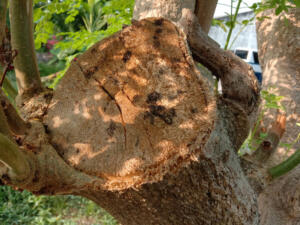
Healthy trees make your property more beautiful, provide shade, and add value to your home. Unfortunately, many trees in New Jersey are under attack by invasive pests and diseases that can cause serious damage or even kill them. These threats often go unnoticed until the harm is already done, which is why understanding what to look for and how to respond is so important.

Emerald Ash Borer: The Hidden Killer
The Emerald Ash Borer, often called EAB, is one of the most destructive invasive insects ever found in the United States. Since first appearing in New Jersey, it has spread quickly and wiped-out countless ash trees.
What to Watch For:
You might notice thinning leaves near the top of the tree, small D-shaped holes in the bark, or bark starting to split. Woodpeckers often target these trees because they feed on the larvae living inside.
What You Can Do:
If your ash trees are still healthy, insecticide treatments may help protect them. Unfortunately, if the infestation has already advanced, removal is usually the safest option. A professional inspection from Big Foot Tree Service can help you decide whether treatment or removal makes sense for your trees.
Asian Longhorned Beetle: A Risk to Maples and More
The Asian Longhorned Beetle targets many popular hardwoods in New Jersey, including maple, birch, elm, and willow. While some areas have been cleared of infestations, the pest remains a threat and can reappear without warning.
Signs of an Infestation:
Look for round exit holes about the size of a pencil, sawdust-like shavings near the tree’s base, or oozing sap. These are strong indicators that beetles have burrowed inside.
How to Respond:
Once this beetle infests a tree, there’s no chemical cure. The affected tree must be removed to keep the beetle from spreading to nearby trees. Early detection and reporting can make a major difference in protecting your neighborhood’s tree canopy.
Oak Wilt: A Silent and Deadly Disease
Oak Wilt is a fungal disease that has been spreading across the eastern United States and poses a serious threat to red oak species. It moves from tree to tree through root systems and insects that carry the spores.
Warning Signs:
Leaves wilt suddenly, often starting at the top of the canopy. They may turn brown along the edges and fall off early in the season. Beneath the bark, you might see discoloration in the sapwood.
Prevention Tips:
Avoid pruning oak trees in the spring and early summer when the fungus spreads most easily. If you suspect Oak Wilt, contact a professional right away. Quick action can help protect surrounding oaks. Sometimes trenching or removal is needed to stop the disease from spreading.
Keeping Your Trees Healthy and Protected
Invasive pests and diseases often spread because of human activity, such as moving firewood or improper pruning. To help prevent infestations:
- Buy and burn firewood locally instead of transporting it long distances.
- Have your trees inspected regularly by a licensed professional.
- Keep trees healthy through proper watering, pruning, and fertilization.
- Report any sudden decline or unusual symptoms you notice.
Partner with a Professional Tree Care Expert
If you’re concerned about the health of your trees or think you may have an infestation, contact Big Foot Tree Service today at 973-885-8000 for a free assessment. We’ll help you protect your trees and your property from these invasive threats.









Recent Comments